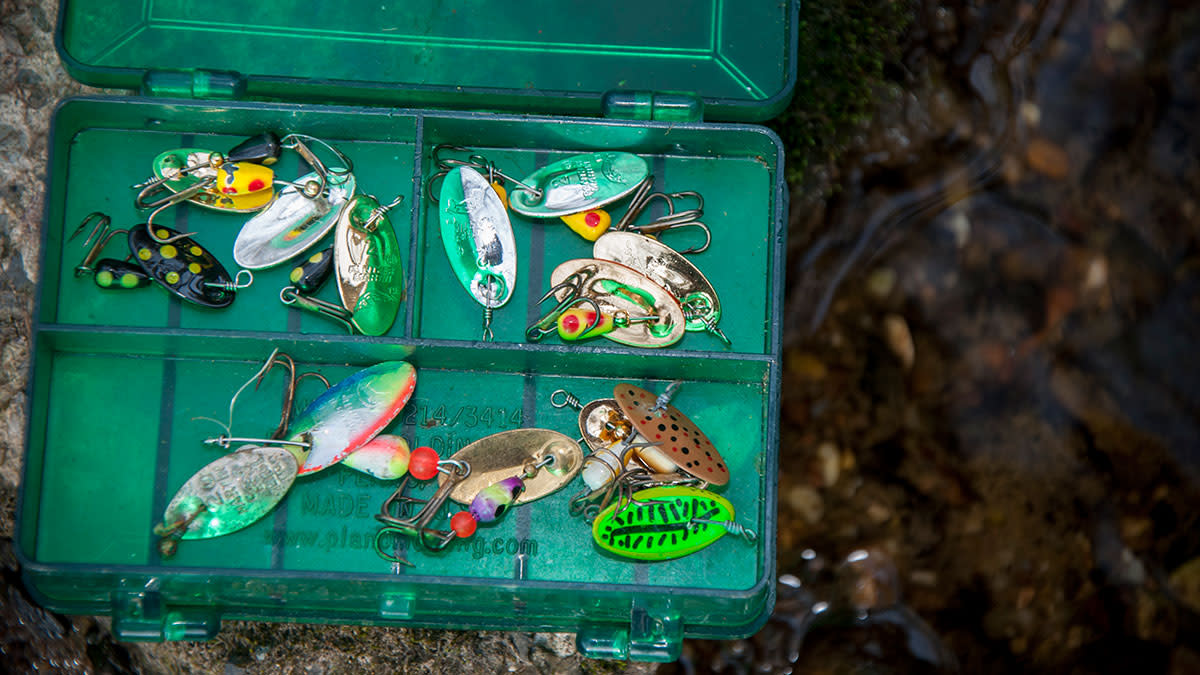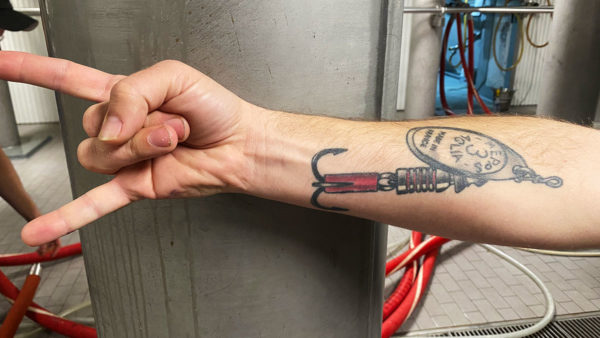
As a “fishing professional,” I should say that I’m a Panther Martin man because the blade starts up instantly at any retrieve speed—a characteristic not shared by all in-line trout spinners. I should also tell you that the weight distribution of the teardrop body helps even the smallest models fly far and land on target. I might add that the absence of a clasp connecting the blade to the post allows for tighter rotation, thereby creating a higher frequency vibration while helping the lure maintain a small profile. These things are all true, but I’m really a Panther man because my uncle was a Panther man.
Northeast trout fishermen are notoriously brand loyal. Talk to a trout guy from Virginia to Maine, and there’s a 95% chance he’s married to one make (and often one model) of in-line spinner. That’s me. There may be a couple Panthers with orange or brown trout blades in my box, but there won’t likely be doubles. Conversely, I don’t feel safe unless I have at least six in sizes 2 and 4; three silver blade with a yellow body, and three gold blade with a black body. Those combinations have never left me wanting, regardless of water conditions, since I was old enough to wear hip boots. They are the colors that earned my uncle a reputation as a local truck trout legend on Stony Brook in Central New Jersey during the ’60s and ’70s. They are, as far as I’m concerned, all you ever need.
Really, though, all you need is whichever in-line spinner you have. That’s what makes this regional and hand-me-down brand loyalty thing kind of nutty. In the vast majority of situations on your average trout stream, any in-line you pull past a fish that’s ready to go gets got. An eager trout isn’t likely to smash a Panther but snub a Mepps.
I could spend pages expounding on this reality, but that’s no fun. Instead, I reached out to a bunch of my Northeast in-line trout fishing cohorts who don’t identify as Panther men so I could record their arguments and poke holes in every single one.
Worden’s Rooster Tail
Avert your eyes from that technicolored wall of Rooster Tails at the tackle shop or you might get sucked in. Many of my good friends have fallen victim, overwhelmingly tempted to taste the rainbow. Worse, they believe weird color combos are most effective. As an example, my friend Dave Edwards says chartreuse with a black-and-chartreuse blade is the best. Isn’t that some ridiculous shit?
My other buddy Jim Fee, who grew up chasing trout in Southeastern Pennsylvania, has a more rational answer. He claims Rooster Tails ruled the roost because they didn’t sink as quickly as Panther Martins, making them more effective on the shallow creeks and streams he frequented. It’s a compelling case, and one I intend to contemplate further while expertly working a Panther with a plain metallic blade through a shallow riffle.
Mepps Aglia
My pal Paul Cain in Western New York is so stuck on Mepps Aglia #3 that he got one stuck on his forearm at the tattoo parlor. Paul told me an ace in his local trout scene turned him on to the Mepps when he was 19, and a copper blade model later scored his biggest hometown brown. He’s convinced that trout associate copper with crayfish, and that the true hogs are particularly fond of the crustaceans. Paul also claims the #3 is just big enough to turn off most smaller trout. I won’t argue over a lure that caught a man’s milestone, but I will say Mepps just feel so Midwestern, don’tcha know? Of all the major in-line brands, seems to me that Northeasterners call out Mepps far less often than others. I always attributed this to Mepps being French and Panther being Italian. A lot more people around here naturally gravitate to sausage and peppers than duck a l’orange.

Blue Fox Vibrax
When I polled my local crew, I was shocked that someone named the Vibrax. I’m talking to you, Jeff Gensheimer. This is a West Coast lure, OK? Have you no cultural values? Yes, I get that you can launch a heavy Vibrax a mile, which might make it a terrific choice for bigger rivers. And yes, I know the Vibrax has a larger cupped blade than most in-lines, producing a thump that in off-color water might draw strikes when others (except for Panther Martins) might not. It’s also reasonable to note that the body of a Vibrax emits a unique low frequency tone created by internal rotating gears hitting a built-in bell. But take that noise to the Olympic Peninsula. Go wrangle a Chinook. When I asked Jeff why the Vibrax was his top pick for Northeast Pennsylvania, he said, “because I saw my dad and uncle fishing them when I was a kid and that stuck with me.” Way to be a follower, man. Way to be a follower.
C.P. Swing
If the C.P. Swing is your go-to trout spinner, you’re probably old. Damn-near wicker creel and linen line old. Strong chance you pulled the first one you ever bought off a card hanging at the malt shop when Eisenhower was still in office. Funny thing is, my friend and blogger Rowan Lytle in Connecticut is not old. He’s 22, and this simple stacked-bead body spinner produces for him. Young Rowan says the large willow leaf blade creates water resistance, so it sinks more slowly than other spinners—a big plus in rocky streams. He also told me these lures have just enough flutter on the drop that they’ll often get plowed before you ever start reeling. On a down note, while Rowan has no trouble buying them on the interwebs via his iPhone 10 with a 5G connection, there’s not a five-and-dime in his area that stocks the C.P. Swing. Try the antique store.
Joe’s Flies
When someone tells me their go-to spinner is a Joe’s Fly, I say, “pick a side already.” For the unacquainted, this West Virginia-based company takes classic fly patterns like the wooly bugger, Gray Ghost, and March Brown, and sticks them on a post with a Colorado blade. I have several buddies who swear by them, including “Have Rods Will Travel” host Josh Dolin in Virginia. Josh explained that while a Joe’s Fly is longer than your average in-line spinner, the overall profile is slimmer and less obtrusive than competitors, making it a ringer when dealing with spooky trout. He also noted that since the treble stinger is attached via a small loop of mono, you lose fewer fish because the free-swinging hook can move and pivot with a brawling trout. This is all well and good and valid, but is it the fly that gets it done or the thump and flash of that blade? If it’s the fly, then just tie on a wooly bugger and fly fish, dammit. If it’s the blade and thump, then they’ll hit any spinner. I’d recommend a Panther Martin.
Featured image via Joe Cermele






Conversation